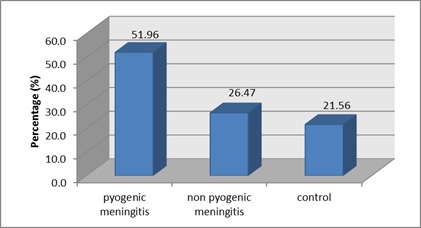“Study of Estimation of Cerebrospinal Fluid C-Reactive Protein in Diagnosis of Acute Meningitis.”
Abstract
Objectives: To assess the diagnostic role of CSF C-reactive protein quantitatively in acute meningitis and to evaluate the efficacy of CSF C-reactive protein in differentiating pyogenic meningitis from non-pyogenic meningitis.
Material and Methods: It is a prospective observational study of total 102 children with suspected meningitis allocated into three groups based on initial investigations; group-I Pyogenic meningitis, group-II Non-Pyogenic meningitis and group-III No meningitis (Control group). Quantitative CSF C-reactive protein was detected by the latex agglutination method. Data were analyzed to establish the diagnostic role of CSF-CRP and to evaluate the efficacy of CSF-CRP in differentiating pyogenic meningitis from non-pyogenic meningitis.
Results: A total of 102 clinically suspected meningitis patients were studied. Based on CSF findings, the study population (102 cases) was categorized into 3 groups. Group I was pyogenic meningitis consist 53 cases (51.96%). Group II was Non-Pyogenic meningitis consists 27 cases (26.47%). Group III was normal CSF findings consist 22 (21.56%). 98.1% cases of pyogenic meningitis had elevated CSF-CRP level >1.1 µg/ml of CSF. In the case of Non-Pyogenic meningitis, 96.2% were found to have CSF- CRP in the range of 0.05-0.10 µg/ml. The mean value of CSF-CRP in groups I, II and III were 5.57±1.48,0.09±0.042 and 0.01±0.010 respectively.
Conclusion: Detection of CSF-CRP provides a new dimension to establish the diagnosis of pyogenic meningitis. It is a rapid, reliable and sensitive diagnostic test. From this study it is concluded that CSF-CRP can be used to differentiate pyogenic from non-pyogenic meningitis. Early, accurate and appropriate therapy can ameliorate the morbidity and mortality rates in such cases.
Downloads
References
Karen L.Roos, Longo,Fauci,Kasper et all. Pyogenic meningitis. In: KennethL.Tyler, editor. Harrison’s principles of internal medicine. 18th ed. United States Of America: McGraw Hill; 2012. p. 3410–20.
Rosenstein NE, Perkins BA, Stephens DS, Popovic T, Hughes JM. Meningococcal disease. N Engl J Med. 2001 May 3;344(18):1378-88. doi: 10.1056/NEJM200105033441807.
Baraff LJ, Lee SI, Schriger DL. Outcomes of bacterial meningitis in children: a meta-analysis. Pediatr Infect Dis J. 1993 May;12(5):389-94. doi: 10.1097/00006454-199305000-00008.
Salih MA, el Hag AI, Sid Ahmed H, Bushara M, Yasin I, Omer MI. et al. Endemic bacterial meningitis in Sudanese children: aetiology, clinical findings, treatment and short-term outcome. Ann Trop Paediatr. 1990;10(2):203-10. doi: 10.1080/02724936.1990.11747431.
Salih MA, Khaleefa OH, Bushara M, Taha ZB, Musa ZA, Kamil I. et al. Long term sequelae of childhood acute bacterial meningitis in a developing country. A study from the Sudan. Scand J Infect Dis. 1991;23(2):175-82. doi: 10.3109/00365549109023397.
Deivanayagam N, Ashok TP, Nedunchelian K, Ahamed SS, Mala N. Evaluation of CSF variables as a diagnostic test for bacterial meningitis. J Trop Pediatr. 1993 Oct;39(5):284-7. doi: 10.1093/tropej/39.5.284.
Neuman MI, Tolford S, Harper MB. Test characteristics and interpretation of cerebrospinal fluid gram stain in children. Pediatr Infect Dis J. 2008 Apr;27(4):309-13. doi: 10.1097/INF.0b013e31815f53ba.
Whittle HC, Tugwell P, Egler LJ, Greenwood BM. Rapid bacteriological diagnosis of pyogenic meningitis by latex agglutination. Lancet. 1974 Sep 14;2(7881):619-21. doi: 10.1016/s0140-6736(74)91943-6.
Chowdhury MZU, Rahman KM, Miah RA, SattarH, Hussain T. Bacterial Meningitis in children. Bangladesh Medical Journal .1991;:3–7.
Brown RL, Zinner SH, Meglio FD, Garrity FL. Countercurrent immunoelectrophoresis in the diagnosis of viral infections of the central nervous system. J Infect Dis. 1978 Dec;138(6):911-5. doi: 10.1093/infdis/138.6.911.
Pemde HK, Harish K, Thawrani YP, Shrivastava S, Belapurkar KM. C-reactive protein in childhood meningitides. Indian J Pediatr. 1996 Jan-Feb;63(1):73-7. doi: 10.1007/BF02823870.
Tillett ws, francis t. Serological reactions in pneumonia with a non-protein somatic fraction of pneumococcus. J exp med. 1930 sep 30;52(4):561-71. Doi: 10.1084/jem.52.4.561.
Pepys MB, Hirschfield GM. C-reactive protein: a critical update. J Clin Invest. 2003 Jun;111(12):1805-12. doi: 10.1172/JCI18921.
Corrall CJ, Pepple JM, Moxon ER, Hughes WT. C-reactive protein in spinal fluid of children with meningitis. J Pediatr. 1981 Sep;99(3):365-9. doi: 10.1016/s0022-3476(81)80319-8.
Horsfall, F. L. Jr., Tamm, I. "Viral and Rickettsial Infections of Man." . J B Lippincott Company, Philadelphia. 1965;pp:1167–8.
Pepys MB. C-reactive protein fifty years on. Lancet. 1981 Mar 21;1(8221):653-7. doi: 10.1016/s0140-6736(81)91565-8.
de Beer FC, Kirsten GF, Gie RP, Beyers N, Strachan AF. Value of C reactive protein measurement in tuberculous, bacterial, and viral meningitis. Arch Dis Child. 1984 Jul;59(7):653-6. doi: 10.1136/adc.59.7.653.
McCarthy PL, Frank AL, Ablow RC, Masters SJ, Dolan TF Jr. Value of the C-reactive protein test in the differentiation of bacterial and viral pneumonia. J Pediatr. 1978 Mar;92(3):454-6. doi: 10.1016/s0022-3476(78)80448-x.
Peltola HO. C-reactive protein for rapid monitoring of infections of the central nervous system. Lancet. 1982 May 1;1(8279):980-2. doi: 10.1016/s0140-6736(82)91989-4.
Clarke D, Cost K. Use of serum C-reactive protein in differentiating septic from aseptic meningitis in children. J Pediatr. 1983 May;102(5):718-20. doi: 10.1016/s0022-3476(83)80242-x.
Vaidya AK, Wagle NM, Merchant SM. Use of CSF C-reactive protein in differentiating bacterial and non-bacterial meningitis. J Postgrad Med. 1987 Apr;33(2):58-60.
Singh N, Arora S, Kahlon PS. Cerebrospinal fluid C-reactive protein in meningitis. Indian Pediatr. 1995 Jun;32(6):687-8.

Copyright (c) 2021 Author (s). Published by Siddharth Health Research and Social Welfare Society

This work is licensed under a Creative Commons Attribution 4.0 International License.


 OAI - Open Archives Initiative
OAI - Open Archives Initiative


